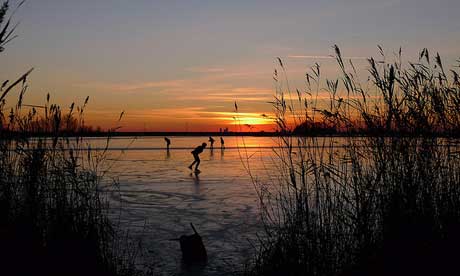
Wanderlust gives you the in-line track on where to go ice skating in the Netherlands
My passion for Dutch ice-skating started 15 years ago when I was living in the canal-crossed city of Delft during a ten-day freeze. I’d already ‘studied’ skating technique as demonstrated by the muffled-up skaters in the paintings of Averkamp and Brueghel. With the first scabbing of ice across the Netherlands’ canals, I joined my Dutch friends to swoop and glide into an exciting and ephemeral wilderness.
Actually it was more skids and tumbles, but with a bit of practice on the local duck pond I mastered a rough approximation of the classic skate-touring pose. Hands clasped behind my back, and legs lazily scissoring back and forth, I was ready to waltz-slide at a steady 15km/h into a nation almost doubled in surface area by the freezing of its watery bits.
Yes! But how do I join in with all this icy frolicking?
Ah, there’s the problem. Unlike mountains or oceans, which are always there to climb up or sail across, a good freeze only comes from a win in the climatic lottery. Thus the chance for the Dutch to be wild adventurers on their own land comes only every few years.
And then a few keen skaters skid around on the ice for a day or two, right?
No, actually. Pretty much the whole country closes down while everyone takes to the ice. Kids traditionally demand: “Wij willen ijs vrij!” – “We want ice time!”. But then so do all the adults.
Still, surely you must need to be an obsessive skater in a Lycra bodysuit to attempt the long tochts (tours)?
Only if you want to skate the 200km cross-country race around the ‘11 cities’ course in less than seven hours. Even then, 16,000 non-racing amateurs start before dawn to follow the same 200km, with most managing to cross the finish line before midnight.
Absolutely. Ice as a landscape has one welcome similarity to a mountain range. It’s there for everyone, whatever their ability. There are plenty of shorter tochts, and they’re all delightfully Dutch in character.
Follow a 40km tour around the windmills that line the canals and lakes surrounding Leiden, for instance. Or skate-ramble down to Vlaardingen to buy a certain kind of biscuit that, traditionally, you tuck into your sock to carry home. Or you can blade between Gouda and Rotterdam with a long, clay ‘Alderman’s pipe’ tied to your belt – if it remains intact, it means you didn’t take a fall along the way.
You’ll enter the wonderful, romantic world of the authentic, traditional Netherlands – a country of reed-scribbled banks, hidden farmyards, steaming dung heaps and russet-cheeked locals. You’ll glide across solidified, frosted lakes with fish frozen into the ice. Occasionally, Beano-style wooden warning signs lean out of jagged holes announcing ‘Gevaarlijk Ijs’ (dangerous ice) as the surface cracks and groans with the shifting temperatures. Reed-bed speakeasies sell shots of gin and Jaegermeister to chilled bladesters, and the ice crackles electrically as ice-athletes shoot past in tight crocodile formations called trentje – ‘little trains’.
Well, for a start forget the hard-core all-in-one skates – learn from Brueghel’s skating peasants who wore Frisian doorlopers that strap on over everyday boots. They’re cheap to buy secondhand or new, and when your ankles have turned to jelly, you can just unstrap them and walk away.
Never skate alone, or away from other skaters, and always stick to recognised routes where the ice has been checked for strength. Avoid ice under bridges, near to factory outflows, under trees or close to locks. Fields flooded to make outdoor rinks provide the safest ice to learn on.
Figuring out how to stop should be your first priority, and for goodness sake keep warm. Speedy skaters – you never know, you might be a natural! – tuck sheets of newspaper down the front of their trousers to avoid windchill-assisted hypothermia.
Who knows? It could be any winter – it could be this winter. Keep an eye on the weather in East Anglia – hard frosts in the Fens mean every chance of good skating ice on the Continent. Then a quick call to the Netherlands to get the local lowdown, a last-minute flight and next thing you know you’ll be blading into the heart of a Dutch masterpiece. Though you might want to learn how to say ‘ik wil ijs vrij’ convincingly to your boss, first.
In exceptionally cold winters the water meadows of the Fens can freeze. The Lamb and Flag Inn at Welney is the spiritual home to Fen skating – check the forecast, check the website and get your skates on.